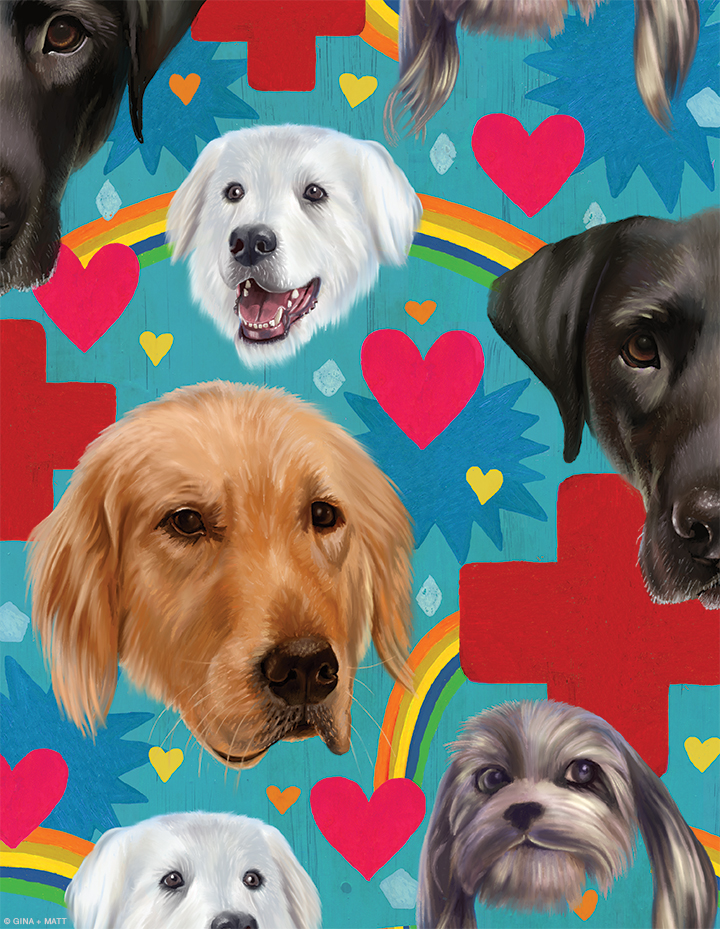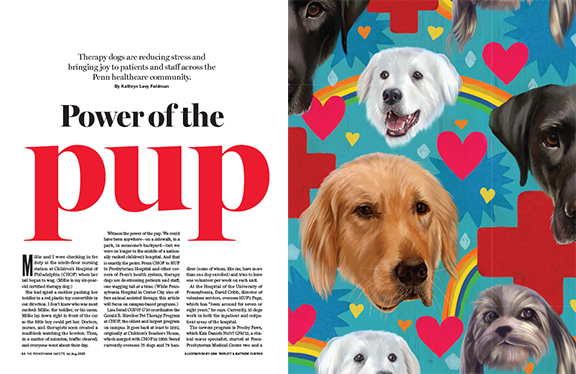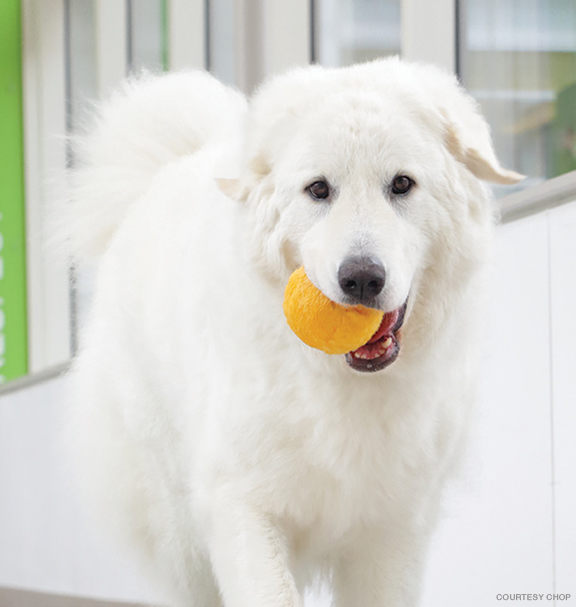
Therapy dogs are reducing stress and bringing joy to patients and staff across the Penn healthcare community.
By Kathryn Levy Feldman | Illustration by Gina + Matt
Sidebar: Camp Comforters

Millie and I were checking in for duty at the ninth-floor nursing station at Children’s Hospital of Philadelphia (CHOP) when her tail began to wag. (Millie is my six-year-old certified therapy dog.)
She had spied a mother pushing her toddler in a red plastic toy convertible in our direction. I don’t know who was most excited: Millie, the toddler, or his mom. Millie lay down right in front of the car so the little boy could pet her. Doctors, nurses, and therapists soon created a roadblock watching the lovefest. Then, in a matter of minutes, traffic cleared, and everyone went about their day.
Witness the power of the pup. We could have been anywhere—on a sidewalk, in a park, in someone’s backyard—but we were no longer in the middle of a nationally ranked children’s hospital. And that is exactly the point. From CHOP to HUP to Presbyterian Hospital and other corners of Penn’s health system, therapy dogs are de-stressing patients and staff, one wagging tail at a time. (While Pennsylvania Hospital in Center City also offers animal assisted therapy, this article will focus on campus-based programs.)
Lisa Serad CGS’07 G’10 coordinates the Gerald B. Shreiber Pet Therapy Program at CHOP, the oldest and largest program on campus. It goes back at least to 1992, originally at Children’s Seashore House, which merged with CHOP in 1998. Serad currently oversees 75 dogs and 78 handlers (some of whom, like me, have more than one dog enrolled) and tries to have one volunteer per week on each unit.
At the Hospital of the University of Pennsylvania, David Cribb, director of volunteer services, oversees HUP’s Pups, which has “been around for seven or eight years,” he says. Currently, 15 dogs work in both the inpatient and outpatient areas of the hospital.
The newest program is Presby Paws, which Kim Daniels Nu’07 GNu’12, a clinical nurse specialist, started at Penn-Presbyterian Medical Center two and a half years ago. Under the auspices of volunteer services, four dogs and handlers work on the inpatient floors, wherever their services are needed, and also visit staff on the units. “Everybody loves it,” Daniels says. “We are thinking about making paw print magnets that the nursing staff can place on the doorframe of patients’ rooms [if they] verbalize that they would like a dog visit while they’re here.”
“It’s something that’s simply observable as you go around with the volunteers,” says Cribb. “You see that smile on the faces of people, and you know you’re doing something good and part of something good.”
“I’ve been here for almost 47 years, and I’ve had a chance to watch how patients and their families respond to the presence of those wonderful animals,” says Alan Cohen, professor of pediatrics and a member of the CHOP pet therapy advisory team. “Over and over again, I have seen children who are dealing with their own health problem, often with pain, or prolonged hospital stays, and missing their families or friends and in some cases their dogs, just light up when the dog enters the room. It is just phenomenal. And for just that time, they seem to be transported to a different place.”
The American Humane Association defines animal assisted therapy (AAT) as “a goal directed intervention in which an animal is incorporated as an integral part of the clinical healthcare treatment process.” AAT actually dates back to the 1790s in England, where exercise and the presence of animals such as birds and rabbits were part of the treatment regimen at the York Retreat, which pioneered a more humane approach to mental illness.
In the US, the modern movement started in the 1960s with Boris Levinson, a child psychotherapist who noticed that sessions with his patients were more productive when his dog, Jingles, was in the room. “A pet is an island of sanity in what appears to be an insane world,” he wrote. “Whether a dog, cat, bird, fish, turtle, or what have you, one can rely upon the fact that one’s pet will always remain a faithful, intimate friend, regardless of the good or ill fortune life brings us.”
When Levinson presented his findings at the American Psychological Association’s conference in 1961, some were “enthusiastic, some guffawed, and a few others asked whether my dog shared in the fees,” he wrote in his 1969 book, Pet-Oriented Child Psychiatry. These days acceptance is practically universal. Therapy dogs can be found in schools, libraries, nursing homes, hospitals, even some airports. And scientific research has documented the benefits of human–animal interaction in medical as well as nonmedical settings.
A 2012 study found that stroking a therapy dog for between five and 24 minutes resulted in a significant drop in stress hormones like cortisol, adrenaline, and aldosterone, and an increase in social and health-inducing hormones like oxytocin, dopamine, and endorphins. Working with a therapy animal has improved behavior and communication skills in people with autism, anxiety, depression, and other psychological challenges, and also been found to reduce depression among elderly adults with dementia. Petting a dog can lower your blood pressure and heart rate, reduce fear and loneliness, and help you heal.
Pet visits in pediatric hospitals have been shown to provide stress relief, help normalize the hospital setting, and generate positive rapport and morale for patients and their parents. In pediatric oncology patients, pet therapy is credited with improving the overall mood and well-being of patients as well as parents and helping a patient adapt to a therapeutic regimen. One study even documented that just one visit by a canine significantly reduced pediatric patients’ perceived pain after surgery, perhaps by providing a source of distraction.
“I think pet therapy reduces anxiety and sort of normalizes the hospital experience and just helps a kid be a kid,” says Jason Freedman Gr’13, inpatient director of oncology at CHOP.
The findings are similar in adult patients. Hospitalized adults who received pet therapy showed significant improvement in perceived energy levels and significant reduction in pain, respiratory rate, stress/anxiety, and negative mood compared to those who did not visit with animals.
Margaret (Peg) Rummel, an oncology nurse navigator at the Abramson Cancer Center at Penn, brings her therapy dog, Darla, to work on Fridays to visit the medical oncology department, clinics, or hospitalized patients if they have requested a visit. “We did a small survey on what the reaction was to having Darla around, and overwhelmingly the staff’s feedback and the patient’s feedback was very positive,” she notes. Staff reported pre-visit stress levels of 4 or 5 with 5 being the highest level. Stress levels decreased to a 1 or 2 after Darla’s visit. “She makes people laugh, and how can you have a bad day when you’ve got Darla around you, just making you smile and giving you some extra love?”
To apply as a pet therapy volunteer at CHOP, handlers must be 18 or older and dogs must be between one and 10—and be approved as a registered therapy dog through one of four certifying organizations: Pet Partners, Therapy Dogs International, Alliance of Therapy Dogs, or Comfort Caring Canines, which have similar requirements. My dogs Millie and Franklin are both registered through the Alliance of Therapy Dogs.
I also had to complete a background check and pass a test evaluating my handling skills and my dogs’ reactions to strangers and other dogs. Then each dog and I had to complete three visits to a medical facility in which we were supervised and evaluated on our work as a team. Only then could we apply to CHOP’s program.
That process begins with an interview with Serad for the handler (without dog) giving a general overview of the program and a brief tour of the hospital. “We show them how big CHOP is and we go over the good, the bad, the ugly of volunteering here and make sure they have a better idea of what they’re getting into,” she explains.
This is followed by paperwork confirming current immunizations and annual flu vaccine, plus FBI fingerprint clearance, criminal background check, and child-abuse history clearance. I had to sign off on CHOP’s policies of patient and institutional information, confidentiality, and therapeutic boundaries.
Dogs must be current on their vaccinations and rabies booster; must not consume a raw diet (which increases risk of pathological bacterial and protozoal shedding and infection that can compromise patient health); and have an annual physical and behavioral evaluation at Penn’s Ryan Veterinary Hospital.
Once cleared, dogs and handlers attend a two-hour Unit/Patient Care orientation in which Serad reviews the rules of the road, including stringent hand-care regulations: no one can pet dogs without washing their hands or using a bacterial hand wipe or hand sanitizer, before and after the encounter. I travel with my CHOP-provided pack of wipes at the ready and sometimes go through two packs in an hour! In addition, I must use Purell on my hands before and after entering each patient’s room.
Millie and Franklin are permitted to jump on a patient’s bed—with consent, of course—but I must go to the linen closet and get a clean sheet to put down and remove that sheet when we leave the room. Dogs are also not allowed to lick patients, and no patient is permitted to give a dog a treat. Each dog must be bathed within 24 hours of their volunteer shift and for two days before a visit no flea or tick topical can be administered.
At the end of the orientation, Serad assigned us to a unit and took us on a short visit. Then I was required to complete three supervised visits (I alternated dogs) under her tutelage, the last of which required me to find my way to the unit without her—a daunting task!
When reporting for work, Millie and Franklin wear CHOP-provided bandanas and I wear a CHOP blue polo shirt. I am never allowed to wear shorts or open shoes. Each dog also gets an official trading card with their photo and some fun facts about them. Many patients collect the cards. The onboarding process takes between four and six months to complete.
Serad freely admits “there are barriers to entry, the first of which is the dog has to be a registered therapy dog. Everybody thinks their dog is the best, but we need an independent, impartial opinion as to whether the dog is suitable or not.” Which is why the Penn Vet piece is so vital, she says. “I think it’s important to have many sets of eyes on these dogs who are working with some of the sickest patients in the world.”
Alison Seward is the behavior representative at Ryan Veterinary Hospital and has been administering the test for dogs in the CHOP program since the late 1990s. “My role is to see them when they come here for a yearly medical exam to evaluate the safety of their being around patients,” she explains. “I do a simple test for obedience to the handler as well as watch them around other dogs in our waiting area and pay a lot of attention to their willingness and apparent comfort meeting me and interacting with me.”
The pre-certification requirement tends to weed out unsuitable candidates, so “failing the behavior test is vanishingly rare,” she adds, “but if we do see a dog who is obviously distressed, we will say, ‘Why don’t we give this another year?’ It’s in everyone’s best interest not to certify a dog who could not possibly manage.”
Seward herself was the beneficiary of an impromptu therapy dog visit when she was a patient at HUP three years ago. “As I recall, I was up by the elevators and there was one of the volunteers with their Labrador,” she says. “He gave me the dog’s little card and now I have it on my bulletin board.”
HUP’s onboarding process is similar but a bit quicker, forgoing fingerprint checks and no longer requiring its therapy dogs to be evaluated at Penn Vet in addition to precertification. “We do not have a pediatric program, so we don’t worry about the FBI fingerprint,” says Cribb. “We’re not fortunate like CHOP to have a dedicated coordinator, but when we do see applications come through for somebody who has a certified dog, we tend to respond to them quickly because we always have openings for HUP’s Pups volunteers.” Presbyterian’s requirements are the same as CHOP’s, but dogs in the Presby Paws program must be certified in animal assisted therapy specific to healthcare and hospitals.
The lengthy process does self-select a pool of committed volunteers. One example is Flaura Koplin Winston EAS’83 GEng’84 M’88 Gr’89, founder and scientific director of the Center for Injury Research and Prevention and director of the Center for Child Injury Prevention Studies at CHOP, where she is also a distinguished professor of pediatrics. Winston and her dog Dobby, a Miki (a rare breed mix of Maltese, Shi Tzu, Japanese Chin, and Papillon), started volunteering at CHOP last November, working on the trauma floor since that is where her professional interests lie. “It’s very consistent with what I do, and I did a lot of traumatic stress research,” she says. “I can understand a lot of what the kids are going through.”
She feels that Dobby—who, weighing in at seven-and-a-half pounds, is extremely portable and totally nonthreatening—is well suited to this type of work. “If they hold him next to their chest, it’s just this incredible release,” she says. “The very first time I did this, there was a woman who was visiting a relative who asked if she could hold my dog. And she just held him and started crying. He’s just perfect that way. He will just sit there and be fine with it. I feel like I have a special gift to give because I’m also a pediatrician so I can really understand what they’re going through.”
Winston doesn’t hide her professional background, identifying herself as Dr. Winston (“just because that’s my name,” she says), but on a volunteer visit, wearing her blue shirt and with Dobby decked out in his petite bandana, she has found that the patients don’t ask her medical questions. “It’s really all about Dobby,” she says. And as intriguing as the prospect of researching the impact of therapy dogs on trauma victims is, she has refrained. “Personally, this is my joy. This is not my research.”
One of Winston’s most memorable encounters involved a young woman who did not want to get up and walk after her surgery, despite her nurse’s orders. Winston asked her if she wanted to walk Dobby, and that got her to complete two laps around the unit. “Everyone you meet says, ‘This was the bright point of my day,’” she comments.
Every volunteer has their own motivation, which often begins with firsthand experience of animal assisted therapy. When Elena Cappella got her therapy dog—Nessie, a Shetland Sheepdog—in 2011, it was originally to comfort herself. “I retired from a very demanding career expecting to have more time with my mom, but she died a few months later,” she says. “I got Nessie to be my emotional support dog.”
She soon realized that Nessie was very smart and easy to train, and she began pursuing the requirements for therapy dog certification. She recalled that her mother enjoyed it when dogs came to visit her assisted-living facility and was drawn to work at a children’s hospital because she has a granddaughter who went through treatment for kidney cancer in other cities. Cappella and Nessie have been volunteering at CHOP for about six years and work in the rehab unit at Seashore House, as well as in the lobby of the Buerger Center for Advanced Pediatric Care as “greeters” when patients are registering.
Besides volunteering at CHOP, Cappella and Nessie have appeared in events at the Wharton School, the dental school, the graduate chemistry department, the Annenberg School, and at open houses at the Graduate Student Center and some undergraduate departments under the auspices of Comfort Caring Canines, the therapy organization through which Nessie is certified. The team was also included in a doctoral program class at the School of Social Policy and Practice taught from 2017 to 2019 by Katharine Wenocur SPP’11 GrS’18 called Animals in Social Work. CHOP’s Serad was also a guest speaker in the survey course, which explored the history of therapeutic involvement of animals in social work practice, including the wide range of roles that animals play in clinical social work.
For their final project, students researched sub-areas of animal assisted therapy. “Some were focused on the elderly. Some were focused on victims of abuse. Some were focused on folks on the autism spectrum,” Wenocur says. “And in all of these populations there were bodies of evidence that were emerging, saying that this could potentially be really helpful for reduction in symptoms and improvement in quality of life.”
Christina Bach SW’96 Gr’12, the psychosocial oncology content editor for the Penn Medicine cancer education website Oncolink and field liaison at the School of Social Policy and Practice, has seen the benefits of animal assisted therapy firsthand. For the past five years, Bach and her late dog Finn and her current dogs Linus and Huck have been pet therapy volunteers in the radiation oncology waiting area at the Perelman Center.
Bach sets up shop in a corner of the waiting area, asking anyone sitting there if they are comfortable with her being in the vicinity. She covers the chairs, puts up signs identifying her dogs as therapy animals, stocks the area with Purell for pre- and post-petting hand sanitizing, and waits for people to come to her. “The rule here is that we can’t approach people. They need to approach us,” explains Bach. “If they are a little shy and looking longingly at Linus I often say, ‘You’re welcome to pet him. This is Linus. He’s a therapy dog and he’s here for you.’”
Waiting for radiation treatment is highly stressful, and pet therapy is one of many interventions Penn offers in the waiting room, including yoga, music, meditation, and a virtual reality relaxation station, says Fern Nibauer-Cohen, director of patient engagement in the department of radiation oncology. “The pet therapy program is an important component of our quality of life programs.” As an indication of how much this program is valued, during the pandemic it has continued virtually. “We had a virtual gathering of about 15 former patients, structured like a talk show, featuring Christina and her beagles. Everyone loved it,” Nibauer-Cohen reports.
Bach is confident animal assisted therapy is beneficial, “but’s it’s hard to prove the evidence of that,” she admits. “Do you measure biometrics? Do you take somebody’s heart rate and blood pressure before and after they interact with the dog? Or is it all really qualitative, in that we’re just really hearing stories and using this narrative about these experiences with animals?” She does know that “people miss their dogs; they love their dogs. So this is a nice connection for them.”
Bach also appreciates the continuity of her patient encounters. “In radiation oncology, these patients are being treated for four to sometimes eight weeks,” she explains. “So we develop relationships with them and become part of their treatment teams, and we look forward to seeing each other every week.”
Bach has written about her patient encounters on the Oncolink blog. One of her favorites involves a patient who bonded with her late dog Finn. “He came in and kept to himself, looked kind of disheveled, and he loved Finn,” she recalls. “Finn didn’t care if he had showered that day or hadn’t brushed his hair.” The patient noticed that Bach fed Finn multigrain Cheerios as treats. “On the last day of his therapy, he arrived with his hair styled and looking dapper. Everybody was congratulating him, and he took out a box of multigrain Cheerios for Finn,” Bach recalls. “What Finn did was make him feel normal. For him to go out and buy a box of Cheerios for a dog made him feel not so much like a cancer patient but like somebody who was compassionate and cared about this creature who cared about him.”
At CHOP, therapy dogs are an accepted, nontraditional therapy that helps hospitalized patients normalize their experience—but Serad is always mindful that some people believe dogs should not be in hospitals. “That is why we have to be so strict with hand hygiene and all of our other rules around safety, boundaries, and privacy,” she says.
One of the largest barriers is the issue of infection, though Presby Paws founder Kim Daniels says she “dug into the literature and found evidence-based practice, research studies, a whole bunch of support and not one piece of literature evidencing anything negative.” Infectious disease experts are part of Serad’s advisory team at CHOP and helped develop the sanitary protocol that all the hospitals follow.
For the past two years, therapy dogs have even been able to visit some of CHOP’s pediatric oncology patients, based on meeting certain health criteria on a day to day basis. “Obviously if our patients have major infections, or they’re on specific type of contact isolation, or they have bacteria they could easily share, or they’re in the middle of a bone marrow transplant, they’re not able to participate,” says inpatient director Jason Freedman, citing the major categories of concern. “But we were really able to open it up to a large group of the patients undergoing generalized cancer therapy because their immune systems are not as weak, and it really made a world of difference.”
The protocol was developed in conjunction with colleagues in infectious disease as well as on the unit, and in large part because of the “way Lisa runs the program,” he says. “There’s no data to guide you; it’s kind of gestalt. You have to just realize that this is really important for the children and you have to balance quality of life with other things. But I can tell you the smiles on these kids’ faces when you walk in and they’ve had pet therapy, it’s kind of unbelievable.”
Another pediatric population on high-level contact precautions (gown and gloves required to enter their rooms) are patients with cystic fibrosis (CF). Ronald Rubenstein, professor of pediatrics at the Perelman School of Medicine as well as director of the Cystic Fibrosis Center at CHOP and HUP, recognized that his patients—who may be hospitalized for weeks at a time—were excluded from getting pet therapy as part of their inpatient stays. “In collaboration with the infection control colleagues, we came up with a protocol by which the dogs could visit kids with CF,” he says, “and as part of that, we tracked if we would ever have hospital-acquired infections.”
Under the protocol, a therapy dog visits with one CF patient for an extended time, enters and exits via a service elevator, and is not eligible to return for two weeks. A pilot study is currently under way to determine whether or not the dog was transmitting bacteria from the patient and vice versa, developed by Rubenstein and the veterinary school’s Daniel Morris, professor of dermatology, and microbiologist Daniel Beiting.
Through his other research, Morris knew Meghan Davis, an associate professor at Johns Hopkins University, who was investigating similar transmissions of bacteria via the dogs in the pediatric oncology population there. “Meghan had some preliminary data that suggested that using chlorhexidine wipes on dogs could decrease the transmission of these pathogens,” Rubenstein says. Together the group wrote a grant securing NIH funding to investigate whether these wipes could decrease the transmission of bacteria from dogs to humans and humans to dogs.
A clinical trial is in its second year. The first year was mainly about planning. According to Rubenstein, they are currently waiting for approval by the Institutional Review Board to begin data collection, which he hopes will be up and running in the near future. The plan is to use the same dogs over and over and to swab them (nose, mouth, and the “petting zone”) before and after the visit with similar sample collections from the patient.
“If you’re a kid who happens to have CF and the family wants to have a dog as part of their normal family life, then that’s part of being a kid,” says Rubenstein, who owns two Portuguese Water Dogs. “But I don’t have any guiding data to tell me if it’s really OK or not. That’s one of my motivations in this.”
Kathryn Levy Feldman LPS’09 writes frequently for the Gazette.
Camp Comforters

Therapy dogs help children grieving loss.
Laurie Leevy’s son Justin C’95 was very ill during his time at Penn and after graduation, succumbing in 2016 to complications of chronic fatigue immune dysfunction syndrome. For the last 13 years of his life, Justin lived at home and, among other things, helped his mom rehab a rescued Kuvasz dog named Jazz.
(Kuvasz are large white dogs from Hungary, bred to be caretakers of young livestock and guardians of their families—and to “listen to no one,” says Leevy, who nevertheless has owned, trained, and shown this breed since her children were small.)
“With Justin’s help, I took a dog who feared people—especially women—and trained him to get obedience titles, several under women judges,” she recalls. “I think I learned, at an even deeper level, the importance of the canine–human connection watching the importance of the dog in, by then, my disabled son’s life.”
Jazz unfortunately developed metastatic cancer, and in the last stages of his illness, Leevy purchased her current dog Lahdee (registered name: Szumeria’s Taliszman Love in a Mist). “I thought I had gotten Lahdee for Justin who, even during periods of pain and suffering, would walk her almost every day and lie on the floor with her in a heap of cuddles.”
But when Justin passed away just seven months after Jazz, Lahdee became the dog that pulled her forward in her own life. “No matter the grief or the loss, a young dog needs our immediate attention,” she says.
Leevy embarked on a regimen of classes in agility, obedience, rally, and eventually therapy dog certification. She and Lahdee have been volunteering at CHOP since 2018 on the neurology unit, where they have become beloved regulars. Some children are boisterous and active, others withdrawn. In all cases, Lahdee has proved to be a nonreactive big, white, fuzzy girl. “Some people have called her the Peaceful Cloud,” Leevy says.
Through CHOP’s pet therapy program coordinator Lisa Serad, Leevy learned about Camp Erin Philadelphia, a bereavement camp for children six to 17 run by Penn Medicine Hospice. For the past three years, therapy dogs have been part of the camp’s three-day program.
Last summer, Leevy and Lahdee were among the greeters who helped welcome the children to camp. “Kids are a little nervous showing up for the first time, meeting all these new people,” says Eric Trumbower, manager of volunteer services for Penn Medicine Hospice and the camp director. “A dog is a really nice object to focus their attention and ease the transition.”
Lahdee was one of three therapy dogs at camp last summer. Liz Decina, a recreational therapist at Moss Rehab in Philadelphia, and her dog Pender (who is the facility dog at Moss) have volunteered at the camp for the past two years.
“The camp schedule is expertly laid out to cycle through fun activities and then work on grief, interpersonal issues related to the grief, group talk therapy sessions related to grief, and then roll back into fun,” says Decina, who coordinates the camp’s therapy dog program as a volunteer. “This cycle goes on five times a day to create a beneficial relationship with grief and then moves forward to tackle the rest of your day.”
The dogs are involved in expressive activities such as grief and memory circles, participate in the camp preview party and opening ceremonies, and even join in at bedtime. “Last year we ended up with a dog that was in the cabins with the kids getting a story read to them, and the campers fell asleep on the dog,” Trumbower says.
Judy Dinofrio, a registered nurse who has worked in Pennsylvania Hospital’s neonatal intensive care unit for the past 30 years, has seen the effect her eight-year-old golden retriever Apolo has on children struggling with grief.
One little girl was struggling to express her feelings during an activity in which campers were encouraged to place a photo of their loved one on a memory board and talk about them. “Apolo wanted her to pet him, and once they were off playing with each other, she started to open up more,” Dinofrio recalls. “She started telling me about her mother and her cancer and was able to express something through her contact with Apolo. There’s a sense of him not judging, just being there.”
At this writing, Camp Erin Philadelphia is on hiatus due to the coronavirus, but Trumbower intends to add more therapy dogs to camp when it reopens. —KLF




